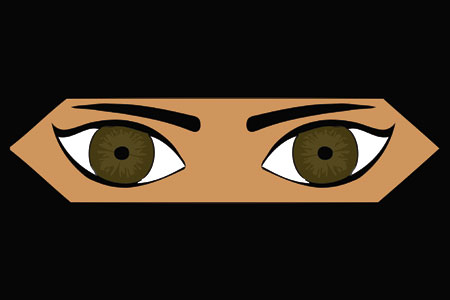
Different Strokes
Issue 72 September 2010
The French and Syrian bans on the niqab may look the same, but underneath they are very different.
Naturally it is gratifying, for those of us who spend significant amounts of time in the Arab world, to see the region get the recognition it deserves. Last month, it was good to see commentators in Europe seize on Syria and Egypt as examples to be followed.
The reason for the praise was Syria’s decision to ban the niqab from university campuses and to bar teachers who wear the niqab from teaching in public schools. Egypt also instituted a bar on the wearing of the niqab during university exams. Some writers, who probably struggled to spell Al-Azhar let alone grasp its significance, waxed lyrical about the debates within Sunni Islam’s foremost seat of scholarship over whether to allow the head-covering.
Yet all of this praise masked a fundamentally illiberal trend, now replicated in France, towards the state imposing what individuals can wear. There are better ways, one imagines, for Europe to follow the Arab world. It is important to distinguish the reasons for the state’s reaction in each case. The social question the two Arab countries face is not the same as the one France faces. Their reaction may be the same, but they are reacting to quite different social stimuli.
France is home to Europe’s largest Muslim population, a group under increasing scrutiny this past decade. There have been tensions in the population over access to employment and living conditions. Proponents of the ban say it preserves the secular nature of the country; opponents say the niqab ban, which affects only a small minority of the country’s Muslims, is political posturing.
The situation in Syria and Egypt is very different. Both are majority-Muslim countries and were the seats of (separate) Arab Muslim empires. Both have long histories of living peacefully with minority groups. The niqab bans are the result of gradual changes in public opinion.
It is now well established that Arab publics are becoming more religious. The reasons for this decades-long change are complex and the contours of each country’s religious complexion difficult to navigate. But broadly, the picture looks like a struggle between Islamist ideas and secular-minded governments.
Secular-minded governments, many of whom have been in power for a very long time, have tried to keep religion out of politics. This was in keeping with the mood of the times when the leaders came to power. But since that was a long time ago, views have changed and now a significant majority want faith to guide politics, the essence of an Islamist outlook.
The Islamist outlook has outward manifestations, one of which has been a rise in the number of women, especially young women, wearing head-scarves. Governments have seen these changes and tried to reflect them, without antagonising the various political factions that keep them in power. In a sense, though, this is merely repairing a crumbling edifice, for what Islamists really want is wholesale political change of a type most of the sitting governments would find unacceptable.
Now even Islamist views are coming under pressure from a more conservative, austere version of Islam. Salafi ideas have gained ground within the Arab world (even if Salafism as a religious grouping remains small), particularly the idea of a withdrawal from a decaying world. These ideas have been manifested most clearly in the wearing of the niqab, even among relatively young women in their teens.
These changes worry the governments of Syria and Egypt, because an increase in Salafi ideas pushes Islamists to be more conservative, to shore up their position as the viable opposition- hence the moves against the niqab by the two governments. It seems likely the hope among the leadership is that the move will send a strong message, while only affecting a small number.
In both cases, and in France, the ban is not a good solution; a temporary fix intended to send a message that is likely to have an opposite effect. In all three places there are real, long-term social changes occurring, and no amount of fixating on a piece of cloth will serve to tackle them.
Faisal al Yafai is a journalist and a Churchill Fellow for 2009/2010
Bookmark this |
|
Add to DIGG |
|
Add to del.icio.us |
|
Stumble this |
|
Share on Facebook |
|
Share this |
|
Send to a Friend |
|
Link to this |
|
Printer Friendly |
|
Print in plain text |
|


Comments
3 Comments
1
Rabi3
25 Dec 10, 19:54
For me i believe that Veil which is "Hijab" in arabic language is a protection for women you can realise that through the name Veil it veils the women from any dangerous situation and believe as a man i would not be interested in a women without veil. human have mind to think and that's the best gift from ALLAH because we can start thinking about things but the problem is if we are able to take the good thing even we don't like it because it makes you feel like having orders and instructions that prevent you from enjoying life "wrong life". if you are a women you can go and ask man about how they react when they say a veiled women and a women without veil???? there is a natural basic moral qualities that leads people to the right way of life. if you are invited to a cermony and your friend offered two cakes one is already packaged and the other women is not. what would you choose to eat which good enough for your health???
2
Nora Kane
26 Oct 10, 19:14
Iftikhar, You must surely acknowledge that it is possible for women to be respectable and decent to live life without fear and with immense enjoyment without the need for a veil.
Kind regards,
Nora.
3
Ifti
30 Sep 10, 16:14
Veil is a sign of woman liberation from Current Naked liberalism, unethical fashion, social harassment, over consciousness about figure etc and become a sex icon and toy of the troy.
Veil is not mere name of piece of cloth but it also has complete women education and training to enjoy her full, fledge life without any fear and become tradable commodity and symbol of enjoyment.
Not covering whole face or not is up to interpretation of various schools of thought and they shall be accountable on their intentions behind interpretation but I have numerous examples around me where women are doing complete veil and they are very much professional and active in every walk of life and living a very "respectable" and healthy life along with every contemporary suitable fashion and ornaments they may feel comfortable with.
Iftikhar Ahmad
http://www.londonschoolofislamics.org.uk